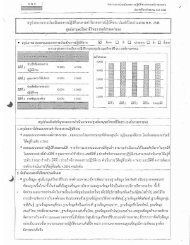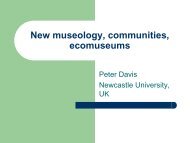Focus on Research:Exploring Cultural Heritage Rightsat the Prasat Hin Phanom Rung Historical Parkby Alexandra DenesDr. Alexandra Denes is a Senior Research Associate at the Sirindhorn Anthropology Centre and the ProjectDirector of the Intangible Cultural Heritage and Museums Field School, Visual Anthropology Program, and theCulture and Rights in Thailand Project at the SAC.The Prasat HinPhnom Rung sanctuary isan ancient Hindu templelocated in Buriram Province.Constructed of sandstoneand laterite between the10th and 12th centuries C.E.and dramatically situated atop an extinct volcano, thetemple originally functioned as a symbol of the Hinducosmos and as a ritual space for the legitimation ofAngkorian era rulers, known as devaraja, or god-kings(Chandler 2000). With the collapse of Angkor in the 15thcentury C.E., the Phnom Rung sanctuary and similarAngkorian era, Hindu religious structures in the regionlost their original symbolic and ritual functions, and yetthey were not completely abandoned. Rather, subsequentsettler populations of ethnic Khmer, Lao, Kui and ThaiKhorat inscribed the sanctuaries with their own mythsand incorporated them into their animist and Buddhistbeliefs and practices.“Many of our local informants toldus that they felt that their values andcultural practices of pilgrimage had beenmarginalized and forgotten in this process ofconstructing Phanom Rung as a major touristdestination and site of national heritage.”Between October 2010and June of 2012, a teamcomprised of myself,Tiamsoon Sirisrisak (MahidolUniversity), RungsimaKullapat (VongchavalitkulUniversity), and staff from theSAC undertook field research with nine communities inthe vicinity of the Prasat Hin Phnom Rung Historical Parkin Buriram province, in order to better understand localresidents’ relationships to the ancient sanctuary and otherarchaeological sites in the park, and to learn more abouthow the sanctuary’s incorporation into Thailand’s nationalheritage had impacted this relationship.From our interviews with local residents of NongBua Lai village, Khok Muang village, Bua village, and TaPek village, among others, we found that Phnom Rungsanctuary and related ancient structures in the vicinityhad long been regarded as sacred abodes of protectivetutelary spirits (chao thi). Every year in April, on the waxing
moon, local villagers would travel by foot and by oxcart tomake a pilgrimage to Phnom Rung, to pay respects to thetutelary spirits of place with incense and offerings, offeralms to the forest monks living in the vicinity, and worshipat the Buddha’s footprint (phraphutabat) which had beenplaced within one of the sanctuary towers. While thereis no archival evidence indicating exactly when theselocal beliefs and pilgrimages began, the French surveyor,Etienne Aymonier, who visited the site in the late 1800sand observed the pilgrimage, suggested that they werepracticed for at least one hundred years (Aymonier 1901).Our informants explained that their ritual relationship toPhnom Rung changed dramatically with the restorationof the sanctuary and opening of the Historical Park in1988. In order to complete the restoration, the Buddhistmonastery, Buddha’s footprint and resident forest monksthat were located near the sanctuary at the summitwere moved down to a plot of land near the base of theancient stairway. This separation of Buddhist and Hindureligious space was more than just an aesthetic choiceof conservationists—it also represented the erasure ofthe syncretic, local, living meanings of the site in orderto inscribe a scientific, archaeological narrative of thesanctuary as part of the nation’s official heritage.The impact of this process of incorporation intonational heritage could also be seen in the transformationof the local, annual pilgrimage into a state-sponsoredcultural spectacle for tourists, featuring reinvented ancientHindu-Brahmin rituals and the staging of a sound andlight performance. Many of our local informants told usthat they felt that their values and cultural practices ofpilgrimage had been marginalized and forgotten in thisprocess of constructing Phnom Rung as a major touristdestination and site of national heritage.Building on these findings from fieldwork, inFebruary 2012, a team from the SAC organized a twodaystakeholder forum entitled “Community Participationin Safeguarding Intangible Cultural Heritage,” withrepresentatives from nine communities in the vicinity of theHistorical Park. The aim of this forum was to invite localresidents to share their beliefs, stories and memories aboutthe archaeological sites within Phnom Rung Park, and todocument these intangible values using a participatorycultural mapping process. Furthermore, in keeping withtwo decades of international legislation in the heritagesector recognizing the intangible values associated withheritage sites and the rights of communities to access andinterpret their cultural heritage, a corollary objective wasto generate recommendations for supporting communityparticipation in the management, use and interpretationof the sanctuaries.In the cultural mapping process, participantsidentified historical paths of pilgrimage to Phnom Rungsanctuary prior to the road construction, and marked thelocations of spirit houses and other mythic and sacredsites within the local landscape. In contrast to standardmaps of the Historical Park which focus predominantlyon the archaeological sites from a either a conservationmanagement or tourism promotion perspective, theresulting cultural map of Phnom Rung offered a compellingvisual affirmation of the longstanding spiritual significanceof the sites to local populations of ethnic Khmer, Lao andThai Khorat, thus rendering these living, intangible aspectsvisible and tangible.In addition to the maps, the stakeholder forumalso generated a substantial list of recommendations fromparticipants about how to support the safeguarding ofthese intangible values. One of these recommendations







